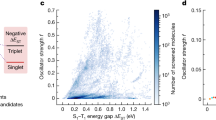Abstract
IT is commonly assumed that the emission spectrum of the delayed fluorescence of an organic material is identical with that of the prompt fluorescence, because the two spectra arise from a radiative transition between the same two electronic levels, although the origin of the excitation differs. Recently a difference has been reported between the prompt and delayed fluorescence spectra of fluorescein in boric acid1,2 and of trypaflavin in polymethyl methacrylate3. Three possible causes of the phenomenon have been suggested2: (1) the possible existence of two metastable (triplet) levels, T1 and T2, in some molecules; (2) intermolecular migration of the triplet excitation energy; and (3) a possible difference in the transition probability distribution for prompt and delayed fluorescence.
Similar content being viewed by others
References
Pohoski, R., Bull. Acad. Polon. Sci. Ser. Sci. Math. Astron. Phys., 10, 505 (1962).
Grzywacz, J., and Pohoski, R., Z. Naturfarsch., 19 a, 440 (1964).
Kawski, A., Z. Naturforsch., 20 a, 1734 (1965).
Author information
Authors and Affiliations
Rights and permissions
About this article
Cite this article
GRZYWACZ, J. Difference between Prompt and Delayed Fluorescence Spectra. Nature 213, 385–386 (1967). https://doi.org/10.1038/213385a0
Received:
Issue Date:
DOI: https://doi.org/10.1038/213385a0
- Springer Nature Limited
This article is cited by
-
A gelable pure organic luminogen with fluorescence-phosphorescence dual emission
Science China Chemistry (2017)





